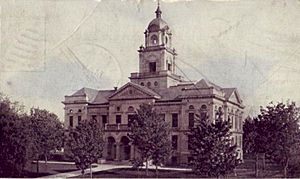Gratiot County, Michigan facts for kids
Quick facts for kids
Gratiot County
|
||
|---|---|---|

|
||
|
||

Location within the U.S. state of Michigan
|
||
 Michigan's location within the U.S. |
||
| Country | ||
| State | ||
| Founded | 1855 | |
| Named for | Charles Gratiot | |
| Seat | Ithaca | |
| Largest city | Alma | |
| Area | ||
| • Total | 572 sq mi (1,480 km2) | |
| • Land | 568 sq mi (1,470 km2) | |
| • Water | 3.1 sq mi (8 km2) 0.6%% | |
| Population
(2020)
|
||
| • Total | 41,761 |
|
| • Density | 75/sq mi (29/km2) | |
| Time zone | UTC−5 (Eastern) | |
| • Summer (DST) | UTC−4 (EDT) | |
| Congressional district | 2nd | |
| Website | https://www.gratiotmi.com/ | |
Gratiot County (/ˈɡræʃɪt/ GRASH-it) is a county in the U.S. state of Michigan. As of the 2020 Census, the population was 41,761. The county seat is Ithaca, although its most populous city is Alma.
Gratiot County comprises the Alma, MI Micropolitan Statistical Area, which is also part of the Mount Pleasant-Alma, MI Combined Statistical Area. The Gratiot County Courthouse was designed in the classical revival style by Claire Allen, a prominent southern Michigan architect. It is one of seven sites in the county listed on the National Register of Historic Places (No. 76002291 added 1976). In June 2012, the 212.8 MW Gratiot County Wind Project opened, the largest wind power installation in the state.
Contents
History
Gratiot County, Michigan is named for Captain Charles Gratiot, who supervised the building of Port Huron's Fort Gratiot. It was described by the Territorial Legislature in 1831. By 1837, the Territory had been admitted to the Union as a state; in 1855 the State Legislature authorized the organization of Gratiot County – the death year of the county's namesake.
Gratiot County was a New England settlement. The original founders of Ithaca and of Alma were settlers from New England, "Yankees", descended from the English Puritans who settled the northeastern coast of the new continent in the 1600s. The Gratiot County settlers were farmers who headed west into what was then the wilds of the Northwest Territory during the early 1800s. Most of them arrived as a result of the completion of the Erie Canal as well as the close of the Black Hawk War. They arrived to virgin forest and wild prairie, but laid out farms, constructed roads, erected government buildings and established post routes. They maintained their customs, such as passion for education, and abhorrence of the existing slave trade. They were members of the Congregationalist Church or the Episcopal Church.
In the 1890s, German immigrants began settling in Gratiot County. See List of Michigan county name etymologies. Emil Lockwood, a noted Michigan legislator, represented Gratiot County in the Michigan Senate from 1963 to 1970, much of the time as Senate Majority Leader.
There are six Michigan historical markers in Gratiot County:
- Alma College
- Gratiot County
- Jackson Weller House
- Lumberjack Park
- Michigan Masonic Home
- Saginaw and Gratiot County State Road / Saginaw Valley & St. Louis Railroad
Geography
According to the U.S. Census Bureau, the county has a total area of 572 square miles (1,480 km2), of which 568 square miles (1,470 km2) is land and 3.1 square miles (8.0 km2) (0.6%) is water. It is considered to be part of Central Michigan.
Adjacent counties
- Midland County – northeast
- Isabella County – northwest
- Saginaw County – east
- Montcalm County – west
- Shiawassee County – southeast
- Clinton County – south
- Ionia County – southwest
Major highways
 US 127 – runs north to I-75 and south to Lansing.
US 127 – runs north to I-75 and south to Lansing.


 Bus. US 127 – business loop through downtown Alma.
Bus. US 127 – business loop through downtown Alma.


 Bus. US 127 – business loop through downtown Ithaca.
Bus. US 127 – business loop through downtown Ithaca.


 Bus. US 127 – business loop through downtown St. Louis.
Bus. US 127 – business loop through downtown St. Louis. M-30 – a north–south highway that runs north into Midland County; runs north to West Branch.
M-30 – a north–south highway that runs north into Midland County; runs north to West Branch. M-46 – cross-peninsular highway that runs east to Saginaw and Port Sanilac; runs west to Muskegon.
M-46 – cross-peninsular highway that runs east to Saginaw and Port Sanilac; runs west to Muskegon. M-57 – runs east to Flint; runs west to US 131 near Grand Rapids.
M-57 – runs east to Flint; runs west to US 131 near Grand Rapids.
Demographics
| Historical population | |||
|---|---|---|---|
| Census | Pop. | %± | |
| 1860 | 4,042 | — | |
| 1870 | 11,810 | 192.2% | |
| 1880 | 21,936 | 85.7% | |
| 1890 | 28,668 | 30.7% | |
| 1900 | 29,889 | 4.3% | |
| 1910 | 28,820 | −3.6% | |
| 1920 | 33,914 | 17.7% | |
| 1930 | 30,252 | −10.8% | |
| 1940 | 32,205 | 6.5% | |
| 1950 | 33,429 | 3.8% | |
| 1960 | 37,012 | 10.7% | |
| 1970 | 39,246 | 6.0% | |
| 1980 | 40,448 | 3.1% | |
| 1990 | 38,982 | −3.6% | |
| 2000 | 42,285 | 8.5% | |
| 2010 | 42,476 | 0.5% | |
| 2020 | 41,761 | −1.7% | |
| 2023 (est.) | 41,368 | −2.6% | |
| US Decennial Census 1790-1960 1900-1990 1990-2000 2010-2018 |
|||
As of the 2000 United States Census, there were 42,285 people, 14,501 households, and 10,397 families residing in the county. The population density was 74 people per square mile (29 people/km2). There were 15,516 housing units at an average density of 27 per square mile (10/km2). The racial makeup of the county was 92.01% White, 3.72% Black or African American, 0.55% Native American, 0.34% Asian, 0.02% Pacific Islander, 1.76% from other races, and 1.60% from two or more races. 4.43% of the population were Hispanic or Latino of any race. 29.8% were of English ancestry, 24.4% were of German ancestry and 6.9% Irish ancestry, 96.1% spoke English and 2.7% Spanish as their first language.
There were 14,501 households, out of which 34.00% had children under the age of 18 living with them, 57.60% were married couples living together, 10.20% had a female householder with no husband present, and 28.30% were non-families. 23.70% of all households were made up of individuals, and 10.70% had someone living alone who was 65 years of age or older. The average household size was 2.57 and the average family size was 3.02.
The county population included 23.80% under the age of 18, 11.60% from 18 to 24, 29.50% from 25 to 44, 21.60% from 45 to 64, and 13.50% who were 65 years of age or older. The median age was 36 years. For every 100 females there were 108.30 males. For every 100 females age 18 and over, there were 109.10 males.
The median income for a household in the county was $37,262, and the median income for a family was $43,954. Males had a median income of $32,442 versus $22,333 for females. The per capita income for the county was $17,118. About 7.30% of families and 10.30% of the population were below the poverty line, including 11.70% of those under age 18 and 9.20% of those age 65 or over.
Religion
The Roman Catholic Diocese of Saginaw is the controlling regional body for the Catholic Church.
Communities
Cities
Villages
Unincorporated communities
Ghost towns
- Bridgeville
- Langport
- Ola
Townships
- Arcada Township
- Bethany Township
- Elba Township
- Emerson Township
- Fulton Township
- Hamilton Township
- Lafayette Township
- New Haven Township
- Newark Township
- North Shade Township
- North Star Township
- Pine River Township
- Seville Township
- Sumner Township
- Washington Township
- Wheeler Township
Education
The Gratiot–Isabella Regional Education Service District, based in Ithaca, services the students in the county. The intermediate school district offers regional special education services, early education programs, and technical career pathways for students of its districts.
Gratiot County is served by the following regular public school districts:
- Alma Public Schools
- Ashley Community Schools
- Breckenridge Community Schools
- Fulton Schools
- Ithaca Public Schools
- St. Louis Public Schools
Gratiot County has the following private schools:
- Countryside Christian School (Mennonite)
- Ithaca SDA School (Seventh-day Adventist)
- St. Mary School (Roman Catholic)
See also
 In Spanish: Condado de Gratiot para niños
In Spanish: Condado de Gratiot para niños


